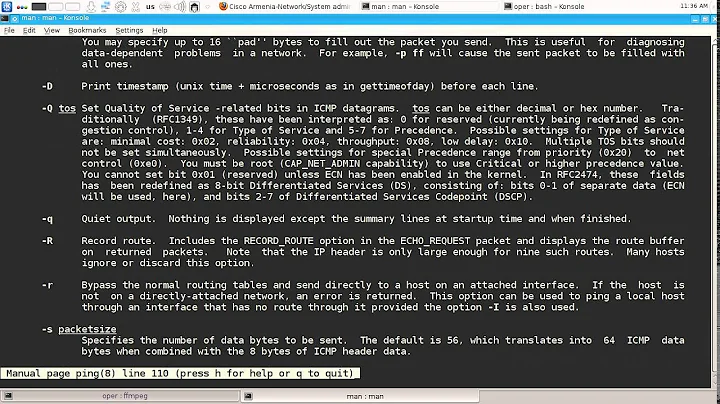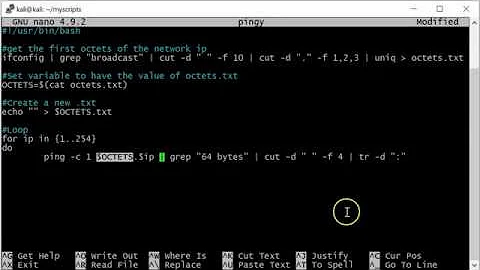Bash ping script file for checking host availability
Solution 1
I would use this, a simple one-liner:
while ! ping -c1 HOSTNAME &>/dev/null; do echo "Ping Fail - `date`"; done ; echo "Host Found - `date`" ; /root/scripts/test1.sh
Replace HOSTNAME with the host you are trying to ping.
I missed the part about putting it in the background, put that line in a shellscript like so:
#!/bin/sh
while ! ping -c1 $1 &>/dev/null
do echo "Ping Fail - `date`"
done
echo "Host Found - `date`"
/root/scripts/test1.sh
And to background it you would run it like so:
nohup ./networktest.sh HOSTNAME > /tmp/networktest.out 2>&1 &
Again replace HOSTNAME with the host you are trying to ping. In this approach you are passing the hostname as an argument to the shellscript.
Just as a general warning, if your host stays down, you will have this script continuously pinging in the background until you either kill it or the host is found. So I would keep that in mind when you run this. Because you could end up eating system resources if you forget about this.
Solution 2
By passing the parameters '-c 30' to ping, it will try 30 ping and stop. It will check after if the command succeeds. I think it is best to do a loop that contains one ping and check if this ping succeed. Something like that:
while true;
do
ping -c1 google.com
if [ $? -eq 0 ]
then
/root/scripts/test1.sh
exit 0
fi
done
If by still running on the foreground, you mean it is still printing on the terminal, you can redirect stdin and stdout to /dev/null .
Solution 3
ping -oc 100000 Hostname > /dev/null && /root/scripts/test1.sh
ping -oexits thepingafter the first packet is received> /dev/nullredirects the output, so you won't see it&&would run the next command, if the previous command ere successful
In addition, you can run any process in the background by adding & to the end of it; for example, echo "123" & will run in the background
Solution 4
An old post, but as a suggestion you can use the -w option on ping to avoid the loop. For example,
ping -w 30 -c 1 host
will try for 30 seconds with one ping per second (default ping has 1 second interval between pings) and will exit on the first successful ping.
If you don't need a timeout, I.e. wait for ever, just use a very large value with -w.
Solution 5
Here is working modification of your script.
#!/bin/bash
ping -c1 10.1.1.23 > /dev/null
if [ $? -eq 0 ]
then
echo ok
exit 0
else
echo “fail”
fi
You need to send the output to /dev/null so it won't appear on the screen.
-c is meant for count. If you put -c30, you're going to ping 30 times before your script can move on to the next line. I use -c1 to make the script run faster.
-i is to wait seconds between sending each packet. So -i3 is to wait 3 seconds. I remove -i to make the script run faster.
Last but not least, use indention so that your code looks nice and easier to read.
Sample output
user@linux:~$ ./script.sh
ok
user@linux:~$
user@linux:~$ ./script.sh
“fail”
user@linux:~$
Related videos on Youtube
dusan90
Updated on September 18, 2022Comments
-
dusan90 almost 2 years
I am trying to write a bash script in a file that would, when run start pinging a host until it becomes available, when the host becomes reachable it runs a command and stops executing, I tried writing one but the script continues pinging until the count ends,
Plus I need to put that process in the background but if I run the script with the dollar (
$) sign it still runs in foreground,#!/bin/bash ping -c30 -i3 192.168.137.163 if [ $? -eq 0 ] then /root/scripts/test1.sh exit 0 else echo “fail” fi -
dusan90 over 9 yearsBy unlocking the prompt so i could work on something else, tnx for help
-
dusan90 over 9 yearsTnx for the answer and the warning, this is a visualized environment so the script will start after the physical servers boot so the VM's will start certainly, but will keep in mind if i delete a VM, tnx again
-
Stephen Kitt over 9 yearsIn particular by logging the failures every time, and storing all the output in a file in
/tmp, if the host goes down you'll end up filling/tmp. That tends to be bad news... -
Thomas about 5 yearsYou also might want to add some explaining words...?
-
Generic Ratzlaugh over 2 yearsThis failed for me with: "3 packets transmitted, 0 received, +3 errors, 100% packet loss, time 2055ms"




